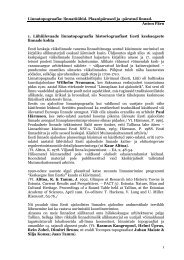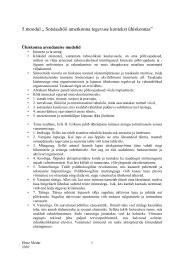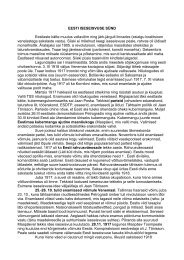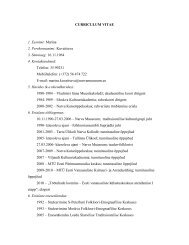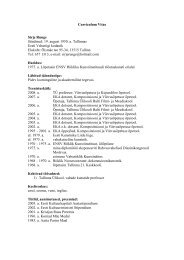crowding and children's mental health: the role of house type
crowding and children's mental health: the role of house type
crowding and children's mental health: the role of house type
Create successful ePaper yourself
Turn your PDF publications into a flip-book with our unique Google optimized e-Paper software.
Crowding <strong>and</strong> Children’s Mental Health 227<br />
An interesting question raised by <strong>the</strong> data is at<br />
what level <strong>of</strong> density do psychological problems begin<br />
to emerge. Unfortunately, nei<strong>the</strong>r <strong>of</strong> <strong>the</strong> <strong>mental</strong><br />
<strong>health</strong> scales contain cut points that would enable a<br />
more straightforward answer to this question. One<br />
alternative way to approach this question is by examining<br />
<strong>the</strong> regression equations for each <strong>of</strong> <strong>the</strong><br />
outcome variables. In <strong>the</strong> case <strong>of</strong> <strong>the</strong> child’s self-reported<br />
<strong>mental</strong><strong>health</strong> (KINDL), for each increment<br />
in residential size <strong>of</strong> one room, <strong>mental</strong> <strong>health</strong> would<br />
be expected to improve 0?14 on a 0^4 scale across<br />
<strong>the</strong> entire sample. For <strong>the</strong> Needleman teacher ratings<br />
<strong>of</strong> behavioralproblems at school, we would expect<br />
to see an improvement <strong>of</strong> 0?40 on a 11^22 scale.<br />
These expected improvements are based on <strong>the</strong><br />
overall sample. If we look only at children residing<br />
in multiple dwelling units, much larger gains are<br />
apparent, 0?36 on <strong>the</strong> KINDL <strong>and</strong> 1.54 on <strong>the</strong> Needleman.<br />
These results also speak to <strong>the</strong> question <strong>of</strong><br />
<strong>the</strong> potentialpracticalsigni¢cance <strong>of</strong> sma le¡ect<br />
sizes. Although <strong>the</strong> R 2 for <strong>the</strong> respective results as<br />
shown above are small for <strong>the</strong> interaction term <strong>and</strong><br />
for <strong>house</strong> <strong>type</strong> <strong>and</strong> medium for <strong>the</strong> density main effect<br />
(Cohen, 1988), when considered in terms <strong>of</strong><br />
changes in well being over a range <strong>of</strong> density for<br />
<strong>the</strong> di¡erent housing <strong>type</strong>s, <strong>the</strong> degree <strong>of</strong> change<br />
in <strong>the</strong> outcome variables is meaningful, particularly<br />
for multiple dwelling inhabitants.<br />
In thinking about <strong>the</strong> implications <strong>of</strong> <strong>the</strong> present<br />
data for <strong>the</strong>ory <strong>and</strong> policy it is important to keep in<br />
mind that <strong>the</strong> extent <strong>of</strong> residential<strong>crowding</strong>,<br />
although from a large, representative sample, is not<br />
very severe. Since truncated variance in <strong>the</strong> predictor<br />
variable reduces estimation <strong>of</strong> covariance in <strong>the</strong><br />
general linear model, <strong>the</strong> present results are likely<br />
conservative (Ghiselli et al., 1981). Eighty-seven percent<br />
<strong>of</strong> <strong>the</strong> sample (1101) live in homes less than or<br />
equalto one person per room, not counting bath<br />
rooms. The U.S. Census Bureau designates residences<br />
greater than one person per room as<br />
crowded. Of <strong>the</strong> remaining 13% living in more<br />
crowded homes, 12% live at two persons per room<br />
or less. Thus within a somewhat restricted range <strong>of</strong><br />
density, residential<strong>crowding</strong> particularly in multiple<br />
dwelling units, may be inimical to children’s psychological<br />
well being. Of course, whe<strong>the</strong>r <strong>the</strong> results<br />
are actually conservative can only be discerned by<br />
replication in o<strong>the</strong>r samples where <strong>the</strong> range <strong>of</strong> density<br />
is greater. Since no o<strong>the</strong>r studies on children’s<br />
self-reported <strong>mental</strong> <strong>health</strong> <strong>and</strong> <strong>crowding</strong> are available,<br />
we cannot speak directly to this speci¢c ¢nding.<br />
For teacher report <strong>of</strong> behavioralproblems in<br />
<strong>the</strong> classroom, data with o<strong>the</strong>r teacher rating scales<br />
from studies at comparable, but low densities in<br />
Canada (Booth & Johnson, 1975) <strong>and</strong> somewhat<br />
higher densities in <strong>the</strong> U.S. (Saegert, 1982) revealsimilar<br />
levels <strong>of</strong> association between residential<br />
<strong>crowding</strong> <strong>and</strong> behavioralconduct in <strong>the</strong> classroom.<br />
A similar rating scale in India, where <strong>the</strong> range <strong>of</strong><br />
density is much greater, revealed a larger association<br />
between <strong>house</strong>hold density <strong>and</strong> problematic<br />
classroom behaviors (Evans et al., 1998).<br />
It is important to keep in mind that <strong>the</strong> design <strong>of</strong><br />
<strong>the</strong> present study precludes drawing causal conclusions.<br />
What we have shown in a cross-sectionaldesign,<br />
is that <strong>the</strong>re are associations between two<br />
physicalvariables, density <strong>and</strong> <strong>house</strong> <strong>type</strong>, <strong>and</strong> two<br />
di¡erent indices <strong>of</strong> children’s well being. What is<br />
new <strong>and</strong> unique to <strong>the</strong> present study, is <strong>the</strong> ¢nding<br />
that <strong>the</strong> relation <strong>of</strong> each <strong>of</strong> <strong>the</strong>se environ<strong>mental</strong><br />
variables with psychological <strong>health</strong> is moderated by<br />
<strong>the</strong> o<strong>the</strong>r. As in prior studies, high-density <strong>and</strong> multiple<br />
dwelling housing, respectively, appear to be<br />
bad for young children. We present novel data indicating<br />
that <strong>the</strong> combination <strong>of</strong> <strong>the</strong>se two environ<strong>mental</strong>variables<br />
may be especially pathogenic. The<br />
o<strong>the</strong>r important new ¢nding is <strong>the</strong> dose^response<br />
data on <strong>house</strong>hold density <strong>and</strong> <strong>mental</strong> <strong>health</strong>. These<br />
data allow estimates <strong>of</strong> threshold e¡ects for density<br />
<strong>and</strong> streng<strong>the</strong>n empiricalevidence for a density-related<br />
<strong>health</strong> impact.<br />
Theoretically, we derived our density by dwelling<strong>type</strong><br />
interaction hypo<strong>the</strong>sis on <strong>the</strong> grounds that<br />
density is believed to be harmful because <strong>of</strong> <strong>the</strong> surfeit<br />
<strong>of</strong> unwanted <strong>and</strong> uncontrollable social interactions<br />
that crowded inhabitants must dealwith<br />
(Altman, 1975; Baum & Valins, 1977, 1979; Mc Carthy<br />
& Saegert, 1979; Saegert, 1982). Housing researchers<br />
also believe that one <strong>of</strong> <strong>the</strong> reasons why high-rise,<br />
multiple dwelling units are related to psychological<br />
distress in young children is because <strong>of</strong> social overload<br />
inside <strong>the</strong> unit created by restricted access to<br />
play areas outside <strong>of</strong> <strong>the</strong> residence (Halpern, 1995;<br />
Evans et al., in press; Gi¡ord, in press). Because<br />
<strong>the</strong> present study was designed as an epidemiologicalinvestigation<br />
<strong>of</strong> environ<strong>mental</strong>quality <strong>and</strong> children’s<br />
<strong>health</strong>, unfortunately no data were collected<br />
on potentialpsychosocialexplanatory mechanisms.<br />
A priority for future research would be to determine<br />
if <strong>the</strong> interaction we have uncovered can be accounted<br />
for by socialoverload.<br />
The housing literature assumes that high-rise living<br />
units in particular are troublesome to young<br />
children. In addition to information on <strong>the</strong> <strong>type</strong> <strong>of</strong><br />
<strong>house</strong>, we also know which £oor each dwelling is located<br />
on in our sample. When we examined this<br />
variable, <strong>type</strong> <strong>of</strong> housing unit, not £oor level, was<br />
important both in terms <strong>of</strong> main e¡ects <strong>and</strong> <strong>the</strong>


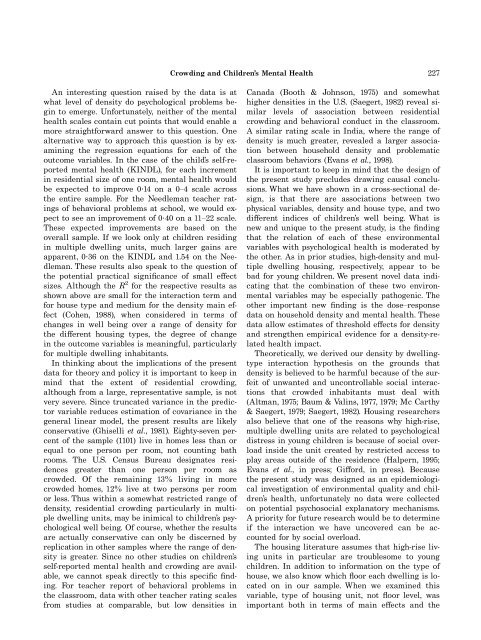
![5 Verben 2 S[1]. 35-44.pdf](https://img.yumpu.com/27096544/1/184x260/5-verben-2-s1-35-44pdf.jpg?quality=85)

